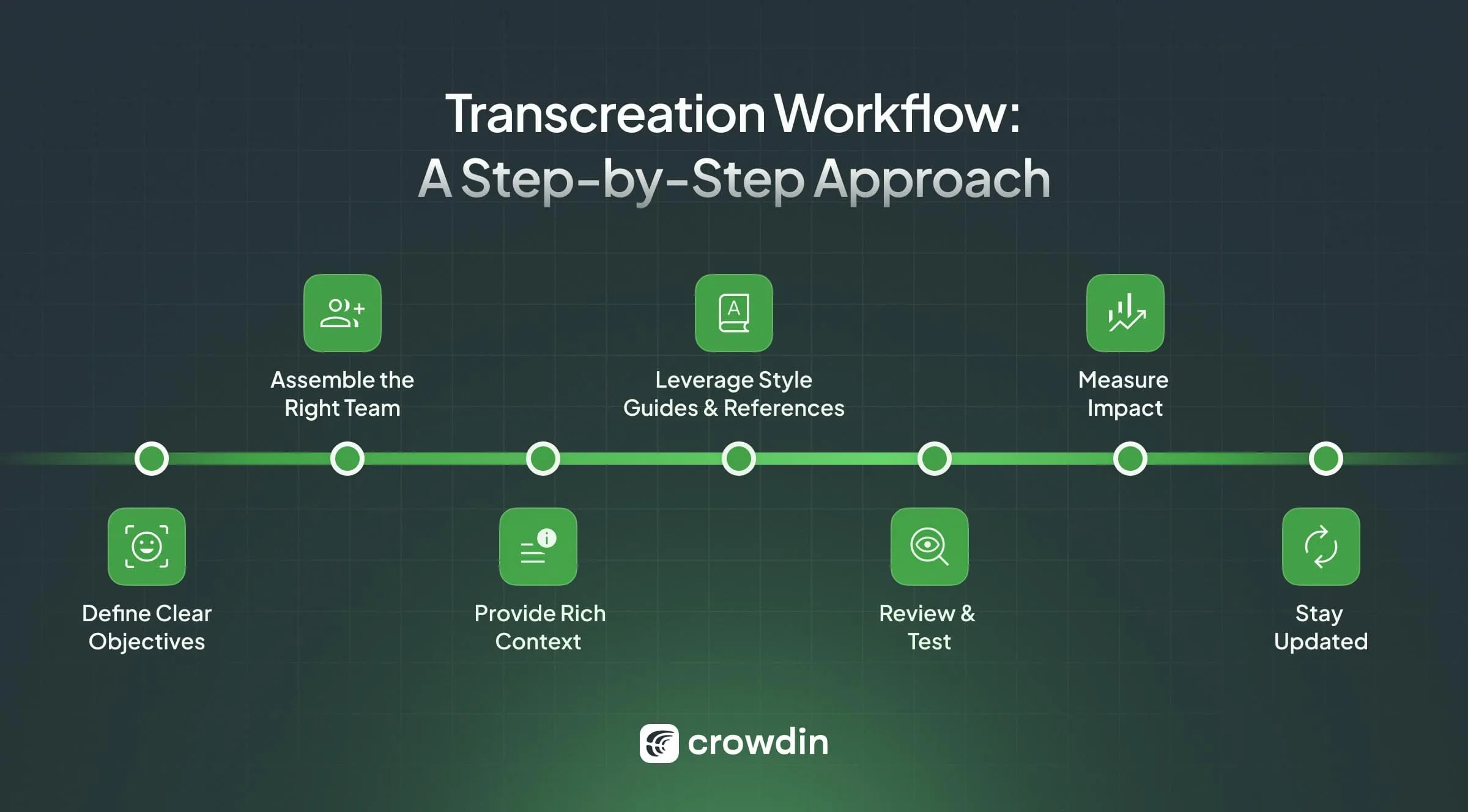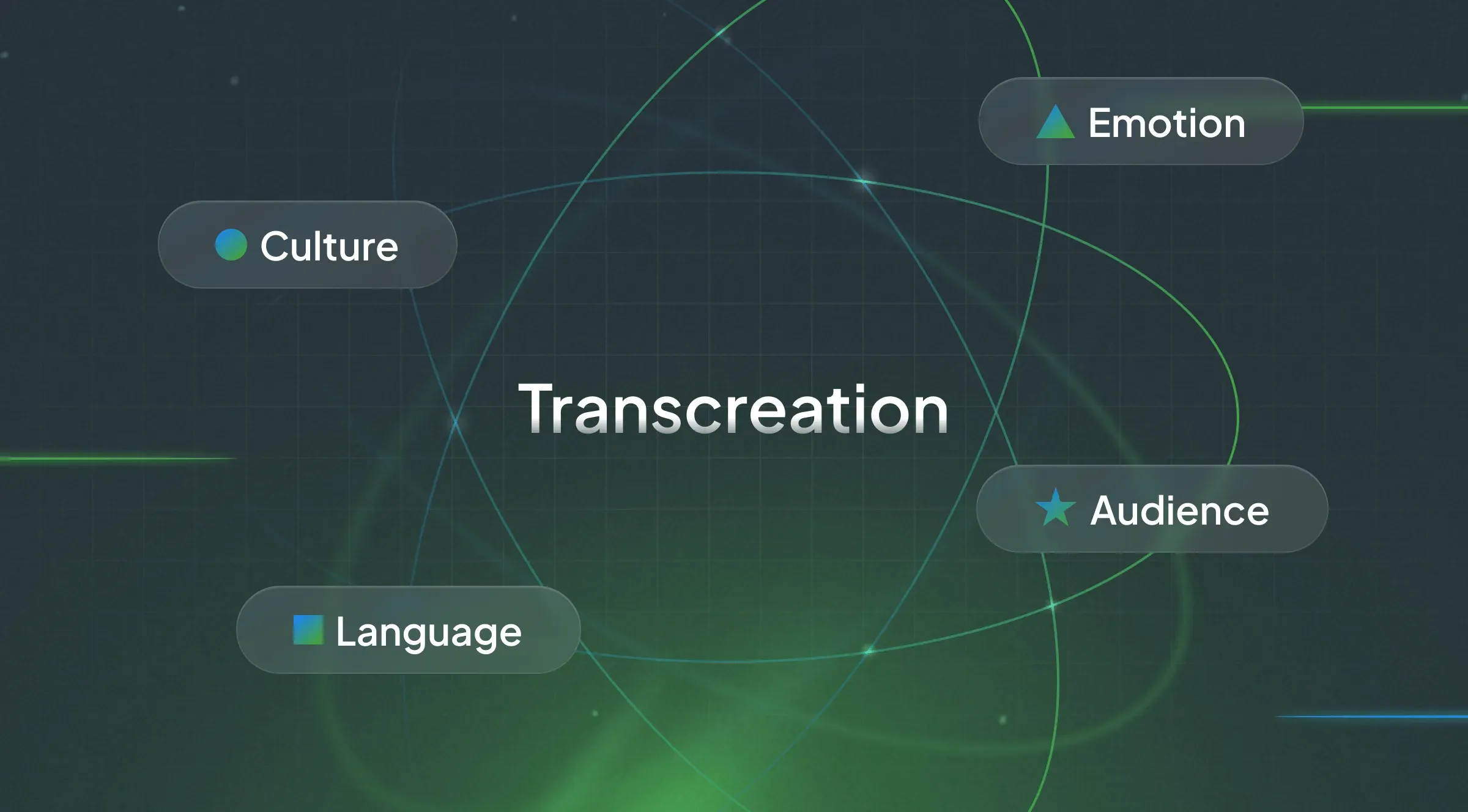This guide explores the key differences between transcreation and traditional translation. You’ll discover why one goes much deeper than the other to help your brand truly connect and succeed in any market.
Quick article overview:
- What’s the difference? Translation focuses on linguistic accuracy (what is said), while transcreation focuses on emotional and cultural impact (how it is received).
- When to use transcreation: Essential for marketing slogans, ad campaigns, brand messaging, and creative content where emotional connection and cultural nuance are critical for success.
- When to use translation Best for technical documents, legal contracts, user manuals, and informational content where precision and literal accuracy are non-negotiable.
- The solution: Crowdin offers tools, including the transcreation app, to manage both processes within a single localization platform.
Keep reading for more detailed explanations and real-world examples.
What is Transcreation
Imagine you have a funny slogan or an ad that makes people feel strong emotions. If you just translate the words into another language, it often loses its power. It might not be funny anymore, or it might not make people feel the same way.
Transcreation is the process of adapting content from one language to another while maintaining its original intent, tone, emotional resonance, and cultural relevance. It’s not just about what you say, but how you say it, ensuring the message evokes the same feeling in the target audience as it did in the source culture.
This process goes beyond linguistics, diving deep into cultural insights, marketing psychology, and creative writing. The goal? To make content that feels like it was originally made for that new language and culture. This helps you build a real connection with your new customers.
What is Translation
Translation focuses on accurately converting text from one language to another while preserving its original meaning. Think of it as a precise linguistic transfer.
The main reason for translation is to share information truthfully and clearly. Translators work very carefully with the original text. They make sure the grammar is correct, the facts are right, and the language is natural in the new language. Good translators understand the context, but their main aim is to be loyal to the original words. This makes it perfect for situations where being exact is very important.
Transcreation vs. Translation: The Key Differences
Transcreation and translation are two distinct approaches to adapting content from one language and culture to another. They serve different purposes and involve varying degrees of creative adaptation.
Here’s a comparison of transcreation and translation:
| Feature | Transcreation | Translation |
|---|---|---|
| Primary Purpose | Evoke the same emotional response & cultural impact; persuade & engage. | Accurately convey meaning & information; maintain linguistic fidelity. |
| Method | Rewriting, cultural adaptation, creative elements, concept recreation. | Direct conversion of words, phrases, sentences, usually word-for-word or phrase-for-phrase. |
| Degree of Freedom | High; able to deviate significantly from the source text to achieve the desired effect. | Low; faithful adherence to the source text’s structure, vocabulary, and meaning. |
| Cost | Typically higher due to intensive creative effort, specialized expertise, and market research. | Typically lower, often charged on a per-word basis. |
| Target Content | Marketing campaigns, advertising slogans, brand messaging, creative writing, video scripts, cultural references. | Technical documents, legal texts, instruction manuals, financial reports, general web content, and academic papers. |
| Skills Required | Creative writing, deep cultural insights, marketing acumen, copywriting, and brand understanding. | Linguistic accuracy, subject-matter expertise, grammar, syntax, and terminology management. |
When Do You Need Transcreation?
Transcreation empowers your brand to achieve specific communication goals that go beyond straightforward language translation. Let’s look at cases where transcreation is very useful.
Marketing and Advertising
Transcreation is commonly used to reach multilingual marketing and advertising, relying on wordplay, cultural references, or humor that may not directly translate into other languages. This way, promotional materials, slogans, taglines, brand messaging, and creative campaigns engage the audience and maintain brand consistency.
Look at these widely-known examples of transcreation from the textbook International Marketing by Philip R. Cateora:
- Example 1: Consider the classic KFC slogan: “Finger Lickin’ Good”. A direct, literal translation into Mandarin Chinese would be something like “Eat your fingers off,” which is unappetizing and culturally inappropriate. Instead, KFC’s marketing in China focused on conveying deliciousness and satisfaction through adapted campaigns.
- Example 2: Another great example is Haribo’s German slogan: “Haribo macht Kinder froh, und Erwachsene ebenso” (Haribo makes children happy, and adults too). In English, this was transcreated to “Kids and grown-ups love it so, the happy world of Haribo!” This ensures the jingle maintains its catchy rhyme and positive feeling, even with a different literal meaning.
Product Names
This often falls under marketing, but it’s crucial enough to highlight. Ensuring a product name doesn’t have unintended negative connotations in a target market is a prime example of transcreation’s necessity.
- Example: Mitsubishi’s “Pajero” SUV, while acceptable in its origin market, carried a derogatory sexual connotation in Spanish. Mitsubishi successfully transcreated the name to “Montero” in Spanish-speaking regions, preventing brand missteps.
Websites and Landing Pages
Different cultures have varying values, norms, and communication styles. Transcreation ensures that your website content aligns with the cultural preferences and sensibilities of the target audience, making your online presence truly resonate.
Keywords
Transcreation includes adapting keywords and localized SEO strategies to improve the visibility of your website or landing page in search engine results for the target audience. It helps potential customers find your content more easily by searching in their native context.
Creative Content
Content that relies on creativity, wordplay, or artistic expression, such as literature, poetry, music lyrics, and creative writing, often benefits from transcreation to maintain its artistic integrity and impact.
- Example: The French biopic about Edith Piaf, originally titled “La Môme” (The Kid/The Little Girl – Piaf’s nickname), was transcreated for international audiences as “La Vie en Rose”. This change leveraged her most famous song, immediately evoking her artistry and emotional essence, thereby connecting more powerfully with a global audience who might not know her nickname but certainly recognize her iconic melody.
Transcreation Workflow: A Step-by-Step Approach
Successful transcreation isn’t a one-off task; it’s a strategic process. Here’s a typical workflow to guide your efforts:

- Define Clear Objectives: Before starting, clearly define what you want to achieve with the transcreated content. What emotions should it evoke? What action should the audience take?
- Assemble the Right Team: Transcreators are not just translators; they’re creative writers, copywriters, and cultural experts. Work with professionals who deeply understand both your source culture and the target market.
- Provide Rich Context: Equip your transcreators with comprehensive briefs, including brand guidelines, target audience demographics, campaign goals, and any cultural sensitivities. The more context, the better the outcome.
- Leverage Style Guides and References: Utilize tools within platforms like Crowdin to store style guides, glossaries, and reference materials. This ensures consistency and empowers transcreators to make informed creative decisions.
- Review and Test: Once the content is transcreated, have it reviewed by native speakers in the target market to ensure it resonates as intended. Test it with focus groups, if possible, to gauge the emotional response.
- Measure Impact: Track the performance of your transcreated content. Is it driving the desired engagement, conversions, or brand awareness? Use these insights to refine future campaigns.
- Stay Updated: Cultures and trends evolve. Continuously update your understanding of target markets and adapt your transcreation strategies accordingly.
The Future of Transcreation
The landscape of global communication is constantly evolving, and transcreation is no exception. As technology advances and brands become truly borderless, the role of transcreation will continue to grow and adapt:
- AI Integration: While human creativity remains central, AI is increasingly assisting transcreators by suggesting context-aware insights, streamlining repetitive tasks, and providing initial drafts. Tools like Crowdin already leverage AI to enhance efficiency and quality, with Agentic AI from Crowdin empowering transcreators to focus on nuanced creative work.
- Real-time Adaptation: The need to respond quickly to global events and trends will lead to more real-time transcreation efforts, especially in dynamic contexts like social media and news.
- Hybrid Models: We’ll likely see more hybrid approaches where AI handles the initial linguistic transfer, and human transcreators then apply the essential creative and cultural adaptation.
- Hyper-Personalization: Brands will continue to push for even more customized and culturally specific content, requiring transcreators to strike a delicate balance between maintaining brand consistency and delivering truly personalized experiences.
Localize your product with Crowdin
FAQ
What is the difference between translation and transcreation?
Translation focuses on changing text accurately while keeping its exact meaning. Transcreation, on the other hand, changes content creatively. It aims to get the same feeling and cultural impact in a new language. This often means changing the words quite a bit from the original text.
How is transcreation different from creative writing?
Transcreation uses a lot of creative writing. But it starts with an original message or idea that needs to be changed for a new market. Pure creative writing often starts with no original text. Transcreators are creative writers who have a special goal: to make the new text have the same effect as the original.
Is transcreation more expensive than translation?
Generally, yes, transcreation is typically more expensive than standard translation. This is due to the higher level of creative effort, cultural research, strategic thinking, and copywriting skills required. It’s often billed hourly or per project, rather than on a per-word basis like many translations.
Yana Feshchuk
Yana Feshchuk is a Partnerships Marketing Manager. Her expertise lies in developing authoritative and well-researched content for the localization field.
